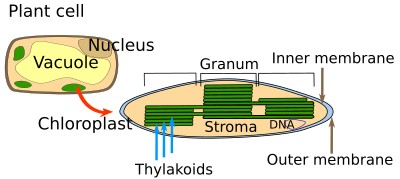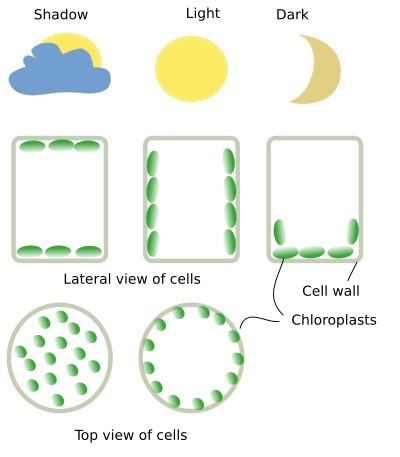1. Morphology
2. Divison, movement
3. Functions
- Photosynthesis
- Others
4. Proteins import
Chloroplasts are generally large organelles (1-10 µm) found in plant cells. A cell from a leaf may contain from 20 to 100 chloroplasts (Figure 1) showing variable shapes, from round to ellipsoid or much more complex. Chloroplasts are members of the organelle plastidfamily and contain DNA with about 250 genes. Chloroplasts produce chlorophyll to capture light energy.

1. Morphology
The morphology of chloroplasts is diverse, particularly in algae, which depends on hydrostatic pressures and mechanosensory ion channels. However, the most common shape is discoidal to oval, although there are star-like, ribbon-like, and many other shapes.
Chloroplasts consist of several compartments (Figure 2). In the periphery, there is an outer membrane, an inner membrane and an intermembrane space between them. Unlike mitochondria, the inner membrane has no folding. Within chloroplasts, there are flat membrane sacs known as thylakoids, usually arranged in stacks referred to as granum. Thylakoids of different grana (plural of granum) may have continuous membranes. Proteins in charge of photosynthesis are located in the thylakoid membranes, which are enriched in galactolipids. Thylakoids can be formed by the fusion of vesicles coming from the inner membrane. The space between thylakoids and the inner membrane is known as the stroma, where DNA, enzymes, ribosomes, and other types of molecules are found. DNA used to be attached to the inner membrane or to the thylakoids.

2. Division and movement
Chloroplasts divide in proliferating cells to provide a proper number of chloroplasts that will perform enough photosynthetic activity in daughter cells. Chloroplast division may be synchronized with cell division. This happens in some algal species, with cells having just one chloroplast. Chloroplast division usually happens during the S phase of the cell cycle, where replication of the DNA takes place. The process is less known in plant species with cells containing many chloroplasts, and in some cells, the number of chloroplasts is not related to cell division. For instance, in parenchymal cells of leaves, chloroplasts divide to increase their number, although the cell is not going to divide anymore. These cells may contain up to 100 chloroplasts, with about 50 DNA copies per chloroplast. In leaf parenchymal cells, it is thought that the number of chloroplasts is regulated by the size of the cell. Curiously, the number of chloroplasts is also related to the surface of the leaf. Regardless, in proliferating cells, the chloroplast population of the mother cell must be split into two rather equal populations and distributed into the two daughter cells. For this segregation, chloroplasts are first moved by actin filaments toward the nuclear surroundings.
The division of chloroplasts depends on some proteins synthesized by the nucleus and others synthesized by the chloroplast itself (all proteins involved in mitochondrial division come from nuclear genes). The division begins with two protein rings, one inner ring composed of chloroplast proteins and an outer ring containing dynamin related proteins coded by nuclear genes. Both rings are connected through transmembrane proteins. The two rings drive the chloroplast division. Unlike mitochondria, the fusion of chloroplasts has not been observed in land plants, although it happens in some green algae during syngamy.
Changing the position of chloroplasts in the cytoplasm is a cell strategy to adapt to variable light conditions (Figure 3). The movement of chloroplasts is slow, around 1 µm/min. A high intensity of light may be harmful for chloroplasts, and a faint light decreases photosynthetic activity. The parenchymal cells of leaves can move the chloroplasts from the periclinal walls (parallel to the leave surface) to the anticlinal walls (perpendicular to the leave surface). Under low light intensity, chloroplasts are moved to the periclinal walls, and under high light intensity, they are moved to the anticlinal walls (Figure 3). Photoreceptors in the plasma membrane trigger the first movement, and those located in the chloroplast are responsible for the second movement.

Actin filaments and myosin motors are found around cloroplasts and drive their movements. The anchoring of chloroplasts near the plasma membrana may also be ruled by actin filaments.
3. Functions
Photosynthesis
Photosynthesis is the main role of chloroplasts. It transforms the electromagnetic energy of light into chemical bonds thanks to chlorophyll, ATP synthase (Figure 4), and ribulose-1,5-bisphosphate carboxylase/oxygenase (RUBISCO). Photosynthesis is divided into two stages: a light-dependent part, where the energy of light is transformed into a gradient of protons used for producing ATP and NADPH, and a light-independent part (which does not need light, but the products generated during the light-dependent stage) where carbon from CO2 is fixed on phosphorylated carbohydrates by RUBISCO. The first stage of the photosynthesis takes place in the thylakoidal membranes, and the second stage in the stroma.

Photosynthesis consists of several steps. a) Photosystem II splits two molecules of water that yield one O2 molecule and four protons. This reaction releases four electrons that are moved to the chlorophyll molecules of photosystem II. There, the energy of light raises the energy of these electrons, and so they are released from the photosystem II. b) The electrons are caught by a plastoquinone and quickly donated to the cytochrome b6/f complex, which uses the energy of electrons to enter four protons into the thylakoid. c) The cytochrome b6/f complex gives the electrons to a plastocyanin that transfers them to the photosystem I. Here, again, thanks to the energy of light, chlorophyll raises the energy of electrons. Ferredoxin-NADP reductase is associated with the photosystem I and transforms molecules of NADP+ into NADPH, which remains in the stroma. The protons that are removed from the stroma and those that are produced or entered into the thylakoid generate a proton gradient across the thylakoidal membrane. This gradient is used by the ATP synthase to produce ATP. Since the catalytic center of the ATP synthase is facing the stroma, the new ATP molecules are synthesized in the stroma. Both NADPH and ATP are eventually used in the Calvin cycle, which is a metabolic chain of reactions where CO2, ribulose-1,5-bisphosphate, and RUBISCO make possible the fixation of carbon into phosphoglycerate.
Another functions
Besides photosynthesis, chloroplasts carry out many other salient functions, such as the synthesis of amino acids, nucleotides and fatty acids, the production of hormones, vitamins and other secondary metabolites. They are also involved in the metabolism of nitrogen and sulfur. Nitrate is the main source of nitrogen for plants. The last step in the assimilation of nitrogen from nitrate is the transformation of nitrite into ammonium, which happens in chloroplasts by nitrite reductase. Nitrite is formed from nitrate. Nitrite and ammonium may be toxic for the cell above a certain concentration, but not nitrate, which can be transiently stored in vacuoles. Some metabolites produced by chloroplasts are involved in protecting against pathogens and in the adaptation of plants to stress, excess water, and extreme heat. By releasing hormones, chloroplasts may also influence cells found far away in the plant.
Chloroplasts are in permanent communication with other compartments of the cell, either by sending molecular signals or through direct contact between their membranes. It is relatively frequent to observe physical contacts between the chloroplast membrane and the membranes of the endoplasmic reticulum and mitochondria. Chloroplasts strongly communicate with the nucleus because it contains many genes for proteins that have to work inside the chloroplast, some of which are needed for photosynthesis. In this regard, the nucleus and chloroplast have to be coordinated because they have to perform functions together.
-
Bibliography ↷
-
Bibliography
Wada M, Kong S-G. 2018. Actin-mediated movement of chloroplasts. Journal of cell science. 131. doi: 10.1242/jcs.210310.
-
 Plastids
Plastids